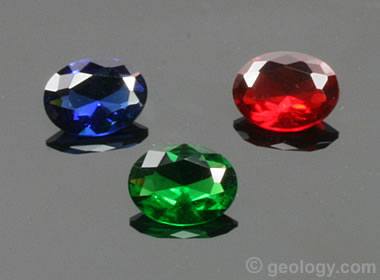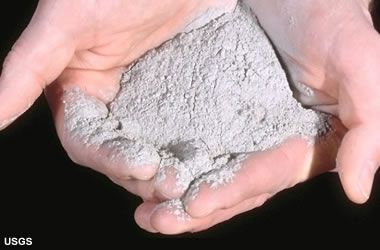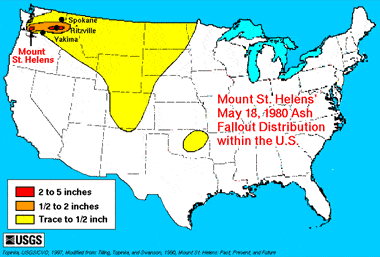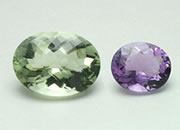Helenite
A novelty colored stone made from the ash of the 1980 Mount St. Helens eruption
Author: Hobart M. King, PhD, GIA Graduate Gemologist

Helenite: Three specimens of faceted helenite in blue, red, and green. These colored stones are faceted ovals about 8 x 6 millimeters in size. They were purchased in 2014 for less than $10 per stone.
What is Helenite?
"Helenite" is a trade name used for a man-made glass that is produced using volcanic ash from the 1980 eruption of Mount St. Helens. It is sold as facet rough, faceted stones, tumbled stones, and mounted in finished jewelry.
The material has been produced in a variety of green, red, and blue hues, which are produced or enhanced by adding coloring agents to the melt. Tourists visiting Mount St. Helens are the primary market for the novelty colored stone jewelry made with helenite.
Table of Contents
 What is Helenite? What is Helenite? History of Helenite History of Helenite Commercial Production of Helenite Commercial Production of Helenite Composition and Physical Properties Composition and Physical Properties Use of Helenite in Jewelry Use of Helenite in Jewelry Minor Ash Content? Minor Ash Content? |

Mount St. Helens Ash: A sample of ash from the 1980 Mount St. Helens eruption, collected a short time after it fell. The freshly fallen ash was typically a light gray powder. USGS image.
History of Helenite
The story of helenite begins shortly after the May 18, 1980 volcanic eruption of Mount St. Helens that blanketed portions of the northwestern United States with a thin layer of volcanic ash. The eruption was widely described in the media, and millions of people became curious about the volcano and the impact of the eruption.
Immediately after the eruption, people who lived near the volcano began sharing samples of the ash with curious friends and relatives. People who lived outside of the eruption area began travelling to the impact area to witness the destruction. Many of them carried home a small amount of ash to show to friends and neighbors. The ash quickly became a souvenir.
A few days after the eruption, workers using an acetylene torch while doing salvage work accidentally discovered that the torch could melt the volcanic ash into a green glass. This story was circulated, and experiments determined that a transparent to translucent green glass could be reproduced in a laboratory by heating samples of ash to 2700 degrees Fahrenheit in a high-temperature furnace followed by rapid cooling.
Commercial Production of Helenite
A few people began producing the glass, cutting it into faceted stones, mounting them in jewelry, and selling the items to tourists. Less than one year after the eruption, Dharma Trading Company began using the name "Helenite" in commerce and filed a trademark with the United States Patent and Trademark Office.
Their trademark was filed to reserve the name "Helenite" for their exclusive use in marketing "glass in the nature of cut gems and rough gems made from volcanic ash from Mount St. Helens, for use in making jewelry." This trademark has been cancelled, but other trademarks have been filed for use of the word "Helenite." Interested people can view information about these filings using the search feature at the United States Patent and Trademark Office website. [1]
Physical Properties of Helenite |
|
| Chemical Classification | Amorphous silicate glass |
| Color | Green, red, blue (colors are probably produced by adding coloring agents to the melt) |
| Streak | White |
| Luster | Vitreous |
| Diaphaneity | Transparent to translucent |
| Cleavage | None, conchoidal fracture |
| Mohs Hardness | 5 to 5.5 |
| Specific Gravity | 2.3 to 2.4 |
| Diagnostic Properties | Hardness, bubble inclusions |
| Chemical Composition | Similar to dacite |
| Crystal System | None - amorphous glass |
| Uses | Cut into faceted colored stones |
Composition and Physical Properties of Helenite
Helenite is a man-made material with properties similar to obsidian. This similarity has led to "Mount St. Helens obsidian," "emerald obsidianite," "ruby obsidianite," and a number of other similar terms being used for the material.
Helenite is made from Mount St. Helens ash, which varies in composition from place to place and is leached of soluble components with exposure to rain water. The ash has a basic composition that is similar to the igneous rock known as dacite. It consists of approximately 65% SiO2, 18% Al2O3, 5% Fe2O3, 4% CaO, 4% Na2O, and 2% MgO. Numerous trace and minor elements also occur in the ash. [2]

Mount St. Helens ashfall map: Map showing the geographic extent of the 1980 ashfall from Mount St. Helens. Image by the United States Geological Survey.
Use of Helenite in Jewelry
Helenite is used in many types of jewelry, including rings, pendants, earrings, and brooches. Depending upon color, it can be an attractive stone. It has a hardness of just 5 to 5 ½ and chips about as easily as obsidian or window glass. It is best used in earrings, pendants, brooches, and other types of jewelry where it will not encounter impact or abrasion. Even in these uses it should be considered to be a very fragile stone. If it is used as a ring stone, the facet edges will be easily abraded, the faces will be easily scratched, and the stone might be chipped with even a slight impact.
People who purchase helenite should know that the material...
 was not produced during the Mount St. Helens eruption was not produced during the Mount St. Helens eruption is man-made is man-made is not rare because it can be produced in great quantities is not rare because it can be produced in great quantities is easily scratched because of its low hardness is easily scratched because of its low hardness chips easily chips easily its color is determined by adding colorants to the melt its color is determined by adding colorants to the melt |
Helenite is a novelty stone, made with tourists to Mount St. Helens as the target market. Without an association with the volcano, interest in the material would probably decline because there are durability concerns and because the material’s appearance is not competitive with other colored stones with superior durability.
| Helenite Information |
|
[1] Trademark Electronic Search System: A search engine on the United States Patent and Trademark Office website that allows visitors to enter a word or group of words and discover trademarks that might be related.
[2] Chemical Composition of Mount St. Helens Volcanic Ash: H.E. Taylor and F.E. Lichte; Geophysical Research Letters, Volume 7, Issue 11, Pages 949-952, November 1980. [3] Green Glass Made of Mount St. Helens Ash?: Kurt Nassau; Gemological Institute of America; Gems & Gemology, Summer 1986, Volume 22, Number 2, November 1980. |
Minor Ash Content?
The Gemological Institute of America compared green glass said to be made from Mount St. Helens ash with a black glass produced using molten ash from the 1980 eruption. They estimated that the green glass contained at most 5% to 10% ash from the volcano. [3]
| More Gemstones |
 |
Birthstones |
 |
Gifts That Rock |
 |
Diamond |
 |
Polka Dot Agate |
 |
Prasiolite |
 |
Bloodstone |
 |
Blue Gemstones |
 |
Tourmaline |

Find Other Topics on Geology.com:

|

| ||

|

| ||

|

| ||

|

|
